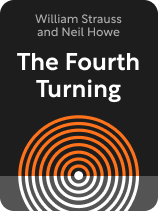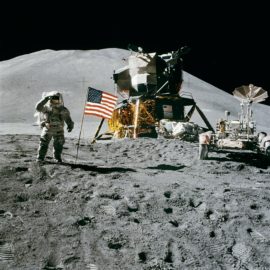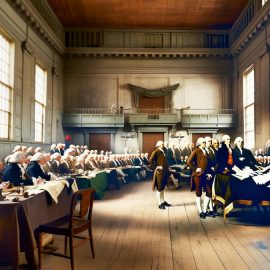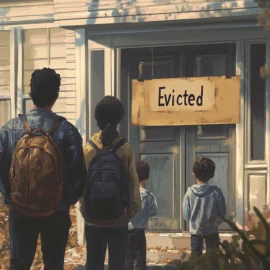

This article is an excerpt from the Shortform book guide to "The Fourth Turning" by William Strauss and Neil Howe. Shortform has the world's best summaries and analyses of books you should be reading.
Like this article? Sign up for a free trial here.
How did the assassination of John F. Kennedy affect America? How did parenting styles change after the 1950s? What reenergized the Republican Party?
According to historian William Strauss and consultant Neil Howe, Anglo-American history goes in phases, which they call Turnings. Each Turning has its own characteristics. They say that the Second Turning is an awakening of sorts, and they call the most recent one “the Consciousness Revolution.”
Read more to learn about Second Turnings in general and America’s most recent Second Turning, from 1964 to 1984.
A Background on the Four Turnings
If you’ve ever noticed that history seems to repeat itself over the course of centuries, you may be wondering what causes that pattern—and how it may play out in the future. Like a single phase of a human life, a Turning lasts around 15 to 25 years.
A single cycle of these four Turnings is called a saeculum. Turnings aren’t characterized by the events that occur during them but rather by society’s reactions to those events. According to the authors, the First Turning is a High, the Second Turning is an Awakening, the Third Turning is an Unraveling, and the Fourth Turning is a Crisis.
The Second Turning: An Awakening
The authors describe the Second Turning as an Awakening. An Awakening occurs when people pull away from the social order imposed during the High, resulting in a cultural revolution. People question and defy the institutions and regulations established during the High as the need for them falls out of living memory. The establishments from the High now seem stifling and inequitable, and people reject them to seek out spiritual fulfillment.
People also reject collective values and the ideals of duty and conformity in favor of individual rights. Government weakens, and free markets begin to overshadow public services. Violence and crime increase, as do income inequality and class divisions. Gender divisions become less strict, and child-rearing becomes more lenient and laissez-faire. Risk-taking becomes more common.
(Shortform note: The authors’ description of an Awakening parallels the phenomenon of teenage rebellion in many ways. Like a society fresh off a High, teenagers are leaving the protection of childhood, seeking their own individual identities, flouting childhood rules that they feel don’t apply to them anymore, rejecting conformity, and taking more risks. Also like an Awakening, some degree of teenage rebellion can’t be prevented and is actually a necessary part of psychological development, according to experts.)
America’s Most Recent Second Turning: The Consciousness Revolution
The Awakening that followed the American High lasted from 1964 to 1984, and the authors termed it the Consciousness Revolution. According to the authors, its beginning was sparked by the assassination of John F. Kennedy at the end of 1963, which shook the nation and incited new social movements rebelling against the now well-established government and social institutions from the High.
Confidence in the nation’s G.I.-built institutions—such as government regulation and spending, labor unions, and corporations—began to waver. People no longer accepted the costs of these institutions, which included the massive power of corporations compared to individuals, police abuse of the poor, and the suffocation of creativity by academia.
(Shortform note: Many of the social movements taking place in this era started as consciousness-raising movements, largely begun by feminist groups. These movements were focused on bringing attention to oppression that people—particularly people in the oppressed group in question—might not be aware of, as opposed to movements that focused on immediate action. Such efforts provided the bedrock for more concrete changes that came later, and consciousness-raising continues to be an important means of promoting modern social movements. The popularization of movements like this in the 1960s and 1970s may be what prompted Strauss and Howe to label this Turning the Consciousness Revolution.)
Boomer Prophets entered young adulthood with no memory of the wartime plights that necessitated these systems. Hero G.I.s (now elders) watched on as the Boomers rebelled against what they had built. Simultaneously, Boomers and the Silent Artist generation (young adults and midlifers) were raising Nomad Xennial children with hands-off parenting styles and little supervision, as the normalization of no-fault divorce led to the highest divorce rates the nation had ever seen.
(Shortform note: No-fault divorce laws allowed spouses to file for a divorce without having to provide evidence that the other spouse did something wrong, whereas prior to the 1970s a couple could only be granted a divorce if one party could be proven to be at fault. The authors suggested that divorce laws would become stricter during the Fourth Turning as a way to reinforce the nuclear family structure, but so far this hasn’t happened. Divorce rates have gone down on their own, though, suggesting that more children are being raised in two-parent homes and that family structures may indeed be getting stronger since the Awakening.)
Violence spread, both in the public eye with the assassinations of Martin Luther King, Jr. and Robert Kennedy, and on a smaller scale with protests against the government and institutional overreach. The Vietnam War further eroded public faith in leadership, not only because it lacked the moral righteousness of World War II, but also because the young Boomer generation rejected the idea that duty to the country outweighed individual rights. As with the moon landing, people felt that the resources spent on this endeavor would be better applied on the homefront to ending poverty and social and racial inequality.
(Shortform note: Though the Vietnam War dealt one of the heaviest blows to the public’s trust in the American government, in the early years of the Turning, public sentiment was largely neutral or split on the topic. Historians note that much of the antiwar attitude came from media coverage showing the brutality and cruelty being carried out by American soldiers. The draft was also a major contributor, as people were forced to fight or die for a cause they didn’t believe in. Others acknowledge that, even while it degraded the public’s faith in the government, the war may have helped promote desegregation, as soldiers of different races worked together and built camaraderie and trust between them.)
The clash between social movements and American materialism led to economic conflict in the 1970s. Environmentalist movements called for a reduction in energy consumption and construction, which led to a decrease in economic supply while demand for goods stayed the same. Inflation from fluctuating oil prices added to this economic crisis and resulted in a stagnation of wages that America still hadn’t recovered from by the time of this book’s publishing in 1997.
(Shortform note: Though the authors attribute the 1970s economic crisis—often referred to as the Great Inflation—to environmentalists’ calls for reduced production of goods, others suggest that it was largely the result of monetary policies enacted by the Federal Reserve. In the early 1970s, the Fed lowered interest rates in an attempt to bring the country out of the recession of the 1960s. While these policies succeeded in that goal, some argue that they flooded the economy with too much money, resulting in a nearly two-decade-long crisis that included four economic recessions.)
The focus on the individual created a culture of self-centeredness that rejected the idea of duty to one’s nation. At the beginning of the Awakening, the young people’s focus on individual rights related mostly to civil rights and issues of culture. However, as the Turning came to a close, individualist sentiment spread to the realm of politics and economics. Conservatives embraced this new ideology and capitalized on the country’s newfound fierce individualism to reignite the Republican Party, electing Ronald Reagan, whose first term brought the end of the Awakening.
(Shortform note: Some argue that Reagan’s presidency is what began the successful dismantling of the institutions established during the American High, as his administration cut over $22 billion of social welfare spending. Though these policies increased poverty and economic inequality, they reflected the renewed American ethos of individualism that has existed since the founding of the nation itself. Additionally, some modern critics suggest that the Reagan era’s embrace and popularization of individualism has led to issues like the massive toll the COVID-19 virus has taken on America, as collective mitigation efforts continue to be overruled by principles of personal liberty and individual responsibility.)

———End of Preview———
Like what you just read? Read the rest of the world's best book summary and analysis of William Strauss and Neil Howe's "The Fourth Turning" at Shortform.
Here's what you'll find in our full The Fourth Turning summary:
- How Anglo-American history follows a pattern of four 15 to 25-year periods
- How the behaviors of different generations define these Turnings
- Predictions about the next Turning—a Crisis






